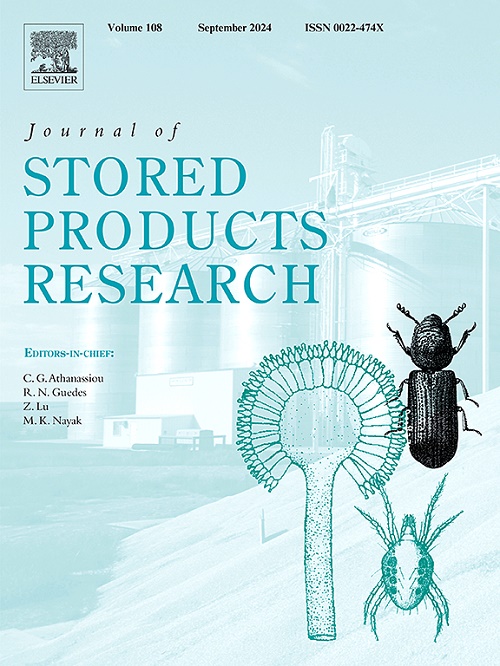Occurrence of toxigenic fungi in raw sago starch for commercialisation in Sarawak, Malaysia
IF 2.7
2区 农林科学
Q1 ENTOMOLOGY
引用次数: 0
Abstract
Fungi are widely distributed in agricultural settings, and certain species are known to cause infections that can impact public health and agricultural production. This study aims to determine the fungal concentration in the raw sago starch samples and to identify the fungal species in the samples. A total of 50 raw sago starch samples for commercialisation were collected from different districts in Sarawak, Malaysia. Enumeration of the fungal concentration was conducted using the serial dilution technique before identification of the fungal genera using morphological examinations. The fungal species were molecularly confirmed using species-specific polymerase chain reaction targeting the ITS region. The findings of this study found the range of fungal counts was 1.3 × 102 to 2.1 × 104 CFU/g (mean: 8.6 × 103 CFU/g). Morphological examinations followed by molecular confirmation revealed 19 fungal species, including Ceratocystis paradoxa (28.89%; 13/45), and followed by Paecilomyces variotii and Peniophora malaiensis (2.22%; 1/45 of each), Penicillium rolfsii and Pleurostoma richardsiae (8.89%; 4/45 of each), Perenniporia tephropora (4.44%; 2/45), Penicillium brasilianum, Penicillium sumatraense, Penicillium verruculosum, Penicillium citrinum, Paecilomyces niveus, Aspergillus sydowii, Aspergillus caesiellus, Aspergillus terreus, Trichoderma pleuroti, Trichoderma harzianum, Candida blattae, and Phaeoacremonium sp. (2.22%; 1/45 of each). All sago starch samples in this study were contaminated with diverse fungal species including mycotoxin-producing species, and the fungal counts exceeded the permissible limits for human consumption. The outcomes from this study provided a baseline on the level of fungal contamination in sago starch for future risk and mitigation assessment planning and established detailed knowledge of the food safety status in sago starch production from Sarawak, which will form a foundation for future studies.
马来西亚沙捞越用于商业化的生西米淀粉中有毒真菌的发生率
真菌广泛分布于农业环境中,某些种类的真菌会引起感染,从而影响公共卫生和农业生产。本研究旨在确定生西米淀粉样本中的真菌浓度,并鉴定样本中的真菌种类。研究人员从马来西亚沙捞越州的不同地区收集了 50 份用于商业化的生西米淀粉样本。在使用形态学检查鉴定真菌属之前,使用系列稀释技术对真菌浓度进行了计数。使用针对 ITS 区域的物种特异性聚合酶链反应对真菌物种进行了分子确认。研究结果发现,真菌计数范围为 1.3 × 102 至 2.1 × 104 CFU/g(平均值:8.6 × 103 CFU/g)。通过形态学检查和分子确认,发现了 19 种真菌,包括 Ceratocystis paradoxa(28.89%;13/45)、Paecilomyces variotii 和 Peniophora malaiensis(2.22%;各 1/45)、Penicillium rolfsii 和 Pleurostoma richardsiae(8.89%;各 4/45)、Perenniporia tephropora(4.44%;2/45)、巴西青霉(Penicillium brasilianum)、苏门答腊青霉(Penicillium sumatraense)、疣青霉(Penicillium verruculosum)、枸橼青霉(Penicillium citrinum)、尼夫酵母菌(Paecilomyces niveus)、西多维曲霉(Aspergillus sydowii)、黑曲霉(Aspergillus caesiellus)、赤曲霉(Aspergillus terreus)、胸膜毛霉菌(Trichoderma pleuroti)、哈氏毛霉菌(Trichoderma harzianum)、白色念珠菌(Candida blattae)和辉绿霉菌(Phaoacremonium sp.)(各占 2.22%;1/45)。这项研究中的所有西米淀粉样本都受到多种真菌的污染,其中包括可产生霉菌毒素的真菌,真菌数量超过了人类食用的允许限度。这项研究的结果提供了西米淀粉中真菌污染水平的基线,为今后的风险和缓解评估规划提供了依据,并详细了解了沙捞越西米淀粉生产的食品安全状况,为今后的研究奠定了基础。
本文章由计算机程序翻译,如有差异,请以英文原文为准。
求助全文
约1分钟内获得全文
求助全文
来源期刊
CiteScore
5.70
自引率
18.50%
发文量
112
审稿时长
45 days
期刊介绍:
The Journal of Stored Products Research provides an international medium for the publication of both reviews and original results from laboratory and field studies on the preservation and safety of stored products, notably food stocks, covering storage-related problems from the producer through the supply chain to the consumer. Stored products are characterised by having relatively low moisture content and include raw and semi-processed foods, animal feedstuffs, and a range of other durable items, including materials such as clothing or museum artefacts.

 求助内容:
求助内容: 应助结果提醒方式:
应助结果提醒方式:


